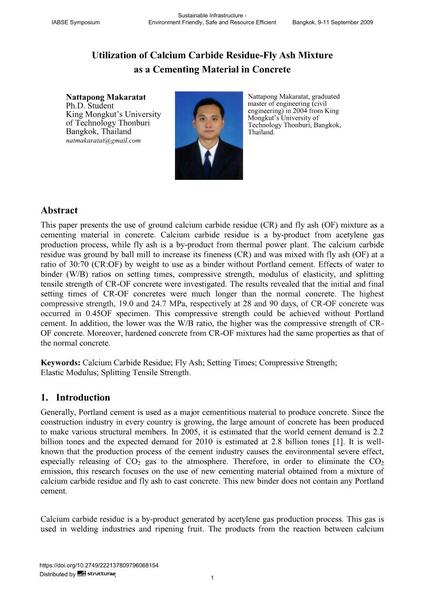Utilization of Calcium Carbide Residue-Fly Ash Mixture as a Cementing Material in Concrete

|
|
|||||||||||
Bibliographic Details
| Author(s): |
Nattapong Makaratat
|
||||
|---|---|---|---|---|---|
| Medium: | conference paper | ||||
| Language(s): | English | ||||
| Conference: | IABSE Symposium: Sustainable Infrastructure - Environment Friendly, Safe and Resource Efficient, Bangkok, Thailand, 9-11 September 2009 | ||||
| Published in: | IABSE Symposium Bangkok 2009 | ||||
|
|||||
| Page(s): | 11-18 | ||||
| Total no. of pages: | 8 | ||||
| Year: | 2009 | ||||
| DOI: | 10.2749/222137809796068154 | ||||
| Abstract: |
This paper presents the use of ground calcium carbide residue (CR) and fly ash (OF) mixture as a cementing material in concrete. Calcium carbide residue is a by-product from acetylene gas production process, while fly ash is a by-product from thermal power plant. The calcium carbide residue was ground by ball mill to increase its fineness (CR) and was mixed with fly ash (OF) at a ratio of 30:70 (CR:OF) by weight to use as a binder without Portland cement. Effects of water to binder (W/B) ratios on setting times, compressive strength, modulus of elasticity, and splitting tensile strength of CR-OF concrete were investigated. The results revealed that the initial and final setting times of CR-OF concretes were much longer than the normal concrete. The highest compressive strength, 19.0 and 24.7 MPa, respectively at 28 and 90 days, of CR-OF concrete was occurred in 0.45OF specimen. This compressive strength could be achieved without Portland cement. In addition, the lower was the W/B ratio, the higher was the compressive strength of CR- OF concrete. Moreover, hardened concrete from CR-OF mixtures had the same properties as that of the normal concrete. |
||||
| Keywords: |
compressive strength fly ash splitting tensile strength elastic modulus Calcium Carbide Residue Setting Times
|
||||
